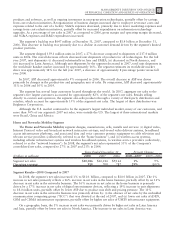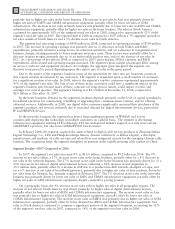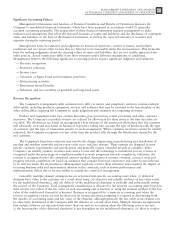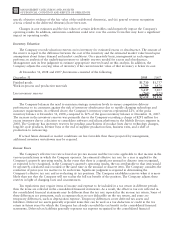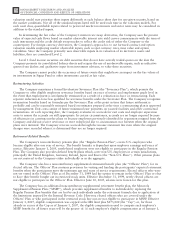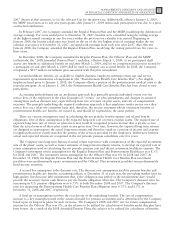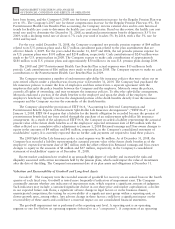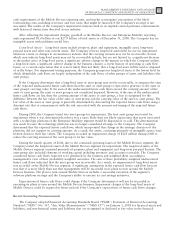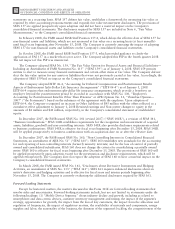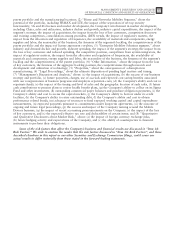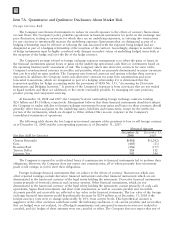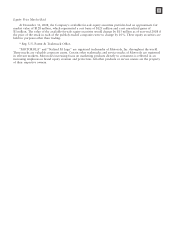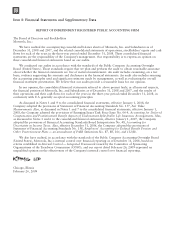Motorola 2008 Annual Report Download - page 81
Download and view the complete annual report
Please find page 81 of the 2008 Motorola annual report below. You can navigate through the pages in the report by either clicking on the pages listed below, or by using the keyword search tool below to find specific information within the annual report.
segment is a reporting unit if the component constitutes a business for which discrete financial information is
available and segment management regularly reviews the operating results of that component. When two or more
components of an operating segment have similar economic characteristics, the components shall be aggregated
and deemed a single reporting unit. An operating segment shall be deemed to be a reporting unit if all of its
components are similar, if none of its components is a reporting unit, or if the segment comprises only a single
component. As such, the Company has determined that the Mobile Devices segment meets the requirement of a
reporting unit. For the Enterprise Mobility Solutions segment, the Company has identified two reporting units, the
Government and Public Safety reporting unit and the Enterprise Mobility reporting unit. For the Home and
Networks Mobility segment, the Company has identified two reporting units, the Home reporting unit and the
Public Networks reporting unit.
The goodwill impairment test is a two step analysis. In Step One, the fair value of each reporting unit is
compared to its book value. Management must apply judgment in determining the estimated fair value of these
reporting units. Fair value is determined using a combination of present value techniques and quoted market prices
of comparable businesses. If the fair value of the reporting unit exceeds its carrying value, goodwill is not deemed
to be impaired for that reporting unit, and no further testing would be necessary. If the fair value of the reporting
unit is less than the carrying value, the Company performs Step Two. Step Two uses the calculated fair value of the
reporting unit to perform a hypothetical purchase price allocation to the fair value of the assets and liabilities of
the reporting unit. The difference between the fair value of the reporting unit calculated in Step One and the fair
value of the underlying assets and liabilities of the reporting unit is the implied fair value of the reporting unit’s
goodwill. A charge is recorded in the financial statements if the carrying value of the reporting unit’s goodwill is
greater than its implied fair value.
The following describes the valuation methodologies used to derive the fair value of the reporting units.
•Income Approach: To determine fair value, the Company discounted the expected cash flows of the
reporting units. The discount rate used represents the estimated weighted average cost of capital, which
reflects the overall level of inherent risk involved in our operations and the rate of return a market
participant would expect to earn. To estimate cash flows beyond the final year of our model, the Company
used a terminal value approach. Under this approach, the Company used estimated operating income
before interest, taxes, depreciation and amortization in the final year of our model, adjusted it to estimate
a normalized cash flow, applied a perpetuity growth assumption and discounted it by a perpetuity discount
factor to determine the terminal value. The Company incorporated the present value of the resulting
terminal value into our estimate of fair value.
•Market-Based Approach: To corroborate the results of the income approach described above, the
Company estimated the fair value of our reporting units using several market-based approaches, including
the value that we derive based on our consolidated stock price as described above. The Company also used
the guideline company method, which focuses on comparing our risk profile and growth prospects to select
reasonably similar/guideline publicly traded companies.
In the fourth quarter of 2008, we conducted our annual assessment of goodwill for impairment. The
Company performed extensive valuation analyses, utilizing both income and market approaches in our goodwill
assessment process. During this quarter, we experienced a sustained, significant decline in our stock price that
reduced the market capitalization below the book value of the Company. The reduced market capitalization
reflected the macroeconomic declines coupled with the market view on the performance of the Mobile Devices
reporting unit. The Company has considered this decline in our stock price in our impairment assessment.
The Company has weighted the valuation of its reporting units at 75% based on the income approach and
25% based on the market-based approach, consistent with prior periods. The Company believes that this
weighting is appropriate since it is often difficult to find other appropriate publicly traded companies that are
similar to our reporting units and it is our view that future discounted cash flows are more reflective of the value
of the reporting units. If a heavier weighting was put on the market based approach for certain reporting units, a
higher fair value would have been determined.
The determination of fair value of the reporting units and assets and liabilities within the reporting units
requires us to make significant estimates and assumptions. These estimates and assumptions primarily include, but
are not limited to, the discount rate, terminal growth rates, earnings before depreciation and amortization, and
capital expenditures forecasts. Due to the inherent uncertainty involved in making these estimates, actual results
could differ from those estimates. The Company assigned discount rates ranging from 13 to 14% for the Home,
Public Networks, Government and Public Safety and Enterprise Mobility reporting units. The Company assigned a
73
MANAGEMENT’S DISCUSSION AND ANALYSIS
OF FINANCIAL CONDITION AND RESULTS OF OPERATIONS


